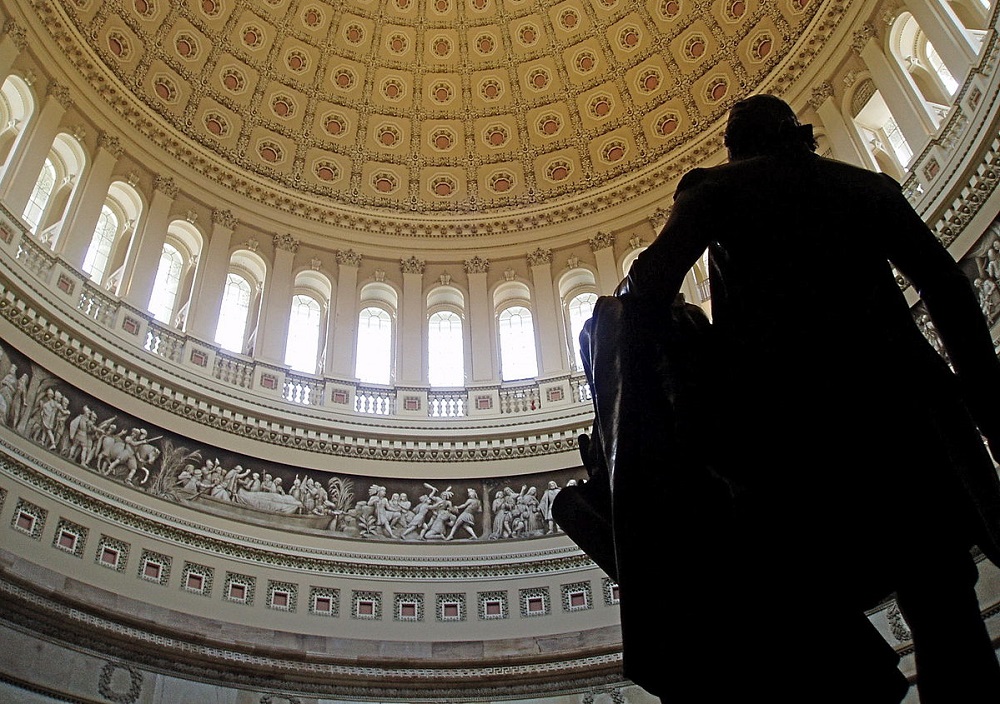Congressional Typologies
Grouping House Members by their voting patterns.

The gang at FiveThirtyEight identify “The 8 Types Of Democrats And Republicans In The House.”
The setup:
A new 538 analysis of voting data reveals that while many members’ formal caucus affiliations matched up pretty well with their voting behaviors, some did not. We analyzed every House floor vote from the first year of the 118th Congress (2023) and applied an algorithm to divide representatives into eight clusters based on similarities in their voting records, using eight official ideological congressional caucuses as a comparison. We then dug into what these clusters say about which issues and votes set members apart, and how these divides fell along the lines of ideology, tenure, district partisanship and more. (See the methodology below for more details.)
We called these clusters “quiet caucuses” to reflect that they’re the unspoken voting cohorts that members align with, regardless of their declared affiliations or how they say they plan to legislate.
The key takeaway:
No matter how we tweaked the parameters, the algorithm produced five Republican clusters and three Democratic clusters, reflecting more division among the GOP conference than among the Democrats. And by including every floor vote in this analysis, from passage of major legislation to doomed “messaging” amendments that were defeated by 60-point margins, our analysis found that some of the biggest differences among Republicans were on messaging.
There are a lot of graphics that I’m not going to attempt to replicate here. But I will excerpt a bit about the group breakdowns themselves.
Far-Right Obstructionists
In a Congress largely defined by Republicans’ struggle to govern in harmony with their far-right flank, it’s no surprise that a cluster of hardline, obstructionist conservatives emerged as a cohesive voting cluster. The Far-Right Obstructionists cluster is made up of 39 members who are part of, or tend to be closely aligned with, the Freedom Caucus, including notable rabble-rousing Trump acolytes like Florida Rep. Matt Gaetz, who led the charge on ousting former House Speaker Kevin McCarthy, and Georgia Rep. Marjorie Taylor Greene, who’s threatening the same fate for Speaker Mike Johnson.
Members of this cluster were both the most conservative and most anti-establishment of all the clusters, according to DW-NOMINATE scores.1 Among them are Freedom Caucus co-founder Jim Jordan of Ohio, current chair Bob Good of Virginia, and other former Freedom Caucus leaders, reflecting that caucus’s embrace of not only ultra-conservative policies, but also obstructionist and attention-grabbing tactics. For example, members of this group proposed and forced votes on an amendment to defund the Occupational Safety and Health Administration, and dozens of separate amendments that each would have reduced the salary of Biden administration officials to $1.
So long as the Republican Speaker refused to work in coalition with Democrats, this group is more than large enough to call the shots. But not that it’s only 39 members strong in a caucus of 221 (down to 217 with resignations).
Far-Right Establishment
The Far-Right Establishment cluster is the largest of the GOP clusters and is stacked with party leaders. That’s notable given that it’s the second-most conservative group in the House.
The 55 members in this cluster are deep-red conservatives who, along with the Far-Right Obstructionists cluster, often broke with the rest of their party in their opposition to government spending bills. Of those who voted, less than 30 percent of members in this cluster supported each of two short-term funding extensions last fall, and only 15 percent supported the final funding package last month. These two groups have also pushed the party posture to the right by largely voting in favor of messaging amendments offered by the Far-Right Obstructionists that put forth libertarian priorities, such as stripping funding from international aid programs and promoting school choice policies. In a notable recent example, 81 percent of the Far-Right Establishment cluster opposed this month’s Ukraine aid package, compared to around a quarter of members across all three of the more moderate clusters.
A look at this group’s impressive roster shows us just how far right the GOP’s power center currently sits: In addition to being the largest of the party’s clusters, the overwhelming majority of House GOP leaders are a part of this group, including the entire floor leadership team — Majority Leader Steve Scalise, Majority Whip Tom Emmer and Chief Deputy Whip Guy Reschenthaler — and seven committee chairs. Speaker Mike Johnson’s voting record would also align him most closely with this cluster.3 Also here are the heads of the major policy-setting arms of the party, House Republican Policy Committee Chair Gary Palmer and Rep. Kevin Hern, the head of the wide-ranging Republican Study Committee.
So, there are two “Far-Right” groups? What makes them distinct, other than that the larger of the two is home to the core leadership?
Appropriately, this cluster diverged from its hardline colleagues in its willingness to take yes for an answer: Outside of critical spending bills, most members joined the rest of the party to support other bipartisan measures like the five-year Federal Aviation Administration reauthorization bill and a package to lower health care costs.
This will strike OTB’s commentariat, which leans decidedly left, as a modest distinction. But I would argue that the Obstructionists are really more Nihilist than Far-Right, in that they’re driven by animus and performance rather than ideology. Almost by definition, they’re not there to pass legislation.
Old Guard Republicans
The Old Guard Republicans cluster is the second-largest GOP cluster and lies in the ideological center of the five. This group of 50 members, along with the 55 in the slightly more conservative Far-Right Establishment cluster, makes up the core base of the House GOP. While most of the party’s leadership is in the latter cluster, a number of key leaders landed in this slightly more moderate group, including House Republican Conference Chair Elise Stefanik and seven committee chairs.
Both groups are on solid footing when it comes to their conservative base, with members representing districts that Trump won in 2020 by an average of around 24 percentage points, but this group was less likely to support some more hardline proposals, including several that proposed significant spending cuts or limits on foreign aid to Ukraine and other countries. Accordingly, just under two-thirds supported this month’s Ukraine aid package, compared to 14 percent of the rightmost two clusters.
Perhaps most strikingly, Old Guard Republicans broke from their spending-skeptical right flank on votes to keep the government funded: Eighty-eight percent supported Speaker Mike Johnson’s controversial November plan to stave off a shutdown, and 66 percent supported this year’s final spending package — compared to only 27 percent and 15 percent of Far-Right Establishment members, respectively.[…]
And by tenure, this cluster does have the most adults in the room. Its members have served an average tenure of 5.5 terms and median tenure of 5 terms, meaning more than half (27 members) have been in Congress for at least 10 years — the most of any GOP cluster.
So, they’re the Old Guard in more ways than one. They are essentially the pre-Tea Party GOP.
Compromise Conservatives
The Compromise Conservatives cluster is the smallest of the GOP groups (32 members) and the second-most moderate on average, though there were some notable exceptions. Like the Moderate Republicans, they broke with more conservative clusters pretty frequently on hard-right messaging votes, supporting only 63 percent of partisan amendments from their own party.
However, this group exhibited slightly more conservative leanings on spending legislation and other traditionally libertarian priorities. Breaking with what we’d expect from a relatively moderate group, members in this cluster were actually less likely to vote for bipartisan spending bills like the annual defense policy bill and September Ukraine aid package than the Old Guard Republicans, who more often fell in line with conservative messaging votes but strongly supported funding bills.
In another example, the Compromise Conservatives were more likely to break with their party by voting to kill an initial resolution censuring progressive Rep. Rashida Tlaib of Michigan for her comments on the Israel-Hamas war, which actually aligned them with the most conservative cluster of the bunch, the Far-Right Obstructionists cluster. Some of these members, like California Rep. John Duarte, expressed concerns that the censure would set a dangerous precedent for free speech, despite condemning Tlaib’s comments.
They don’t break these down by individual Members; my strong guess is that these are primarily Western and Midwestern Republicans.
Moderate Republicans
The Moderate Republicans cluster is a group of 39 members who break more often than others from the majority of their party on both substantive policy and partisan messaging, with the goal of finding consensus across the aisle. For example, 89 percent of the cluster voted in favor of a September 2023 bill to provide security assistance to Ukraine, compared to 38 percent of all other Republicans.
Unsurprisingly, Problem Solvers Caucus Co-chair Brian Fitzpatrick of Pennsylvania is in this group, along with 17 others from the caucus — two-thirds of the group’s GOP members. More than half (22 members) of the similarly pragmatic-minded caucus called the Republican Governance Group also aligns with this cluster, including the caucus’s chair, David Joyce of Ohio, who described the group in 2022 as “hellbent on breaking through Washington’s dysfunction” to “carve out a viable path forward for effective lawmaking.”
In modern times, Congress certainly does a lot of the opposite. Take the annual appropriations process, which has become something of an exercise in partisan posturing and brinksmanship. In September, as GOP leaders struggled to find consensus on spending legislation, House Republicans brought to the floor a proposed agriculture and FDA spending bill that included steep spending cuts advocated by the far right and a controversial rider limiting access to the abortion pill, which made it a clear non-starter for Democrats and parts of this moderate GOP cluster. Forty-five percent of the Moderate Republicans cluster broke ranks with the party to tank this bill’s passage. The House also considered hundreds of partisan “messaging” amendments, which had no real shot at becoming law, but gave members a chance to make their voices heard on policy priorities, or partisan talking points. Moderate Republicans, on average, supported fewer than half (42 percent) of the partisan amendments offered by their own party.
These moderates are ultimately a key voting bloc, and while their aisle-crossing tendencies have been decried by right-wingers in their party, their votes have helped pass critical legislation, such as this year’s government funding bill and the most recent Ukraine aid bill, both of which passed with a minority of GOP votes.
“Moderate” is, of course, a moving target. Most of these folks would likely have been considered “conservative” in the 1980s.
Moderate Democrats
The Moderate Democrats cluster is the smallest Democratic cluster. Seventy-five percent of its members won their seats during either the 2018 or 2022 cycles, making it also the newest Democratic cluster by average term length. The biggest exception to this is Rep. Marcy Kaptur of Ohio, who is the longest-serving woman in congressional history, having been elected to 21 terms.
This cluster is by far the most centrist of the Democratic wing. Last year, the Moderate Democrats voted yes on bipartisan amendments 92 percent of the time, 20 percent more frequently than their progressive colleagues, and they voted for Democratic amendments 11 percent less frequently than the rest of their party. They also voted yes more often on all types of passage, a signal that they were more willing than other Democrats to side with the Republican majority.
Three of the five Democrats who represent districts that Trump won in 2020 are in this cluster: Kaptur, Rep. Jared Golden of Maine and Rep. Marie Gluesenkamp Perez of Washington state. This cluster also contains almost every member of the Blue Dog Coalition, the most moderate Democratic caucus in the House.
I suspect that both of the “Moderate” factions are in relatively competitive districts in purplish states.
Core Democrats
The Core Democrats cluster includes almost half of all Democrats in the House and all but one member of House Democratic leadership, including Minority Leader Hakeem Jeffries (Minority Whip Katherine Clark is in the Progressive Democrats cluster). This cluster is the largest with 100 members and — as you might suspect from the name — is characterized primarily by being squarely in the middle of all the different factions of the Democratic Party, both ideologically and during fights between the party’s insurgent and establishment wings. It contains members from every Democratic caucus that we tracked, including a majority of the New Democrat Coalition.
It’s also the longest-serving cluster in Congress, having been elected to an average of 6.7 terms. That’s partly because much of the aging Democratic establishment can be found here: Seven of the 10 longest-serving Democrats currently in the House are part of this cluster. This older guard contains lots of workhorses, who often stay out of the high-profile clashes between the progressive and moderate wings of their party.[…]
The Core Democrats broke occasionally with their moderate counterparts on some votes, opposing increases to police funding and protections, for example. They also differed from their progressive colleagues on bills relating to foreign policy and the Middle East; for example, most of the cluster voted to prohibit funds to move the U.S. Embassy in Israel back out of Jerusalem, where it was relocated under the Trump administration despite fierce opposition from progressives..
It’s not only the largest Democratic faction but—by far—the largest of any of the eight identified. Given Republican dysfunction—mostly attributable to the Obstructionist wing—it’s really the center of the House. Given that it’s where the leadership resides, it’s actually more meaningful than the Moderate Democrats, as there aren’t quite enough of them (36) to make up for the Obstructionists (39) who refuse to play ball.
Progressive Democrats
The Progressive Democrats cluster includes, naturally, 68 of the most progressive members in Congress, including every member of The Squad. Fittingly, almost every member of this cluster is part of the Congressional Progressive Caucus, but there were still some surprises to be found. One was that Rep. Debbie Dingell of Michigan, a member of the Problem Solvers Caucus, was in this cluster. This was unexpected considering the Progressive Democrats were about 20 percent less likely to vote yes on bipartisan amendments than the other two Democratic clusters, and were also the most anti-establishment of the Democratic clusters, with an average score of -0.31 on the second dimension of DW-NOMINATE.6 And it’s true that Dingell broke with her cluster on a couple of votes where it otherwise had strong consensus. But she still ended up agreeing with the Progressive Democrats more than the average member of the cluster, voting with them over 98 percent of the time,7 including on high-priority issues like criminal justice reform and environmental protection.
Another surprise: while many members of this cluster have made headlines for unseating long-serving representatives in primaries over the last several years, this cluster is actually one of the longest-tenured in the House, having been elected to an average of 6.3 terms. That’s due to the presence of progressive stalwarts like Rep. Maxine Waters of California, the longest-serving member of this cluster, who has been elected to 17 terms.
This cluster broke with the Core Democrats particularly on votes related to foreign policy and the Middle East, voting against prohibiting funds to move the U.S. Embassy out of Jerusalem, in opposition to most of their party. When compared with the Moderate Democrats, this cluster often broke on votes related to crime and policing, voting against legislation attempting to create a police “Bill of Rights” and a resolution condemning efforts to defund the police, which was a particularly major wedge issue during the 2020 cycle.
The Progressives have scant representation in the core leadership of the party but have outsized power in the caucus, as their longevity gives them several key chairmanships. Additionally, it’s the second largest of the eight groups identified.





The Fourth thread has some grammar discussion about lay/lie and such. In the Gingrich era Frank Luntz and the GOP messaging gang managed for a bit to make “liberal” a bad thing. In response, some gutless Dems, but I repeat myself, started calling themselves “progressive”. Over time “progressive” has come to denote the more liberal wing of the Democratic Party. No particular point, just entertained by how language evolves. Perhaps someone will contribute one of the frequent comments that modern Republican “conservatives” aren’t in any way conservative.
Looks like bullshit to me.
If everyone in the end snaps a salute and falls into line, these factions are essentially meaningless. In a second Trump term not one House Republican will have the courage or integrity to resist even his most extreme actions. Not a single one.
Michael said what I was thinking…
I’m reminded of the old joke:
Q: What do you call two really good men having dinner with five Nazis?
A: Seven Nazis
Speaking of liberalism, as I was above, and descriptive of Republicans, Erik Loomis at LGM links to an essay in NYT today by historian Stephen Hahn on the deep seated illiberalism of America. Loomis has a good summary and a link to the whole thing, which is thought provoking.
Mixed in with the occasional FTFNYT stuff, NYT often does something really good like this piece by Hahn.
I came of age, politically and generally, in Piketty’s Les Trente Glorieuses. My life, my friends’ lives, the country and the world seemed to get a little better each year. The Depression, war, and post-war era were, Hahn points out, an aberration as period of liberality. And Piketty points out the overlap of liberality and economic progress weren’t just coincidence. Hahn makes clear it ain’t just Trump. Trump, along with the various taxa of Republicans, above, is just cashing in on deep roots of illiberalism.
I think that it is clear that obstructionist group is distinct from the traditional group.
As noted in the quoted text, Johnson fits into the far-right traditionalist group and was willing to make a deal with Dems. The Obstructionists would not make a deal if they were in charge.
This matters, yes?
I think my comment is vague. I am referencing Ukraine, specifically.
I think it’s a mistake to conflate “moderate” and “centrist” and “bipartisan”. These are three distinct concepts, and getting them mixed up doesn’t increase understanding. The “moderate Republicans” would not only have been considered far-right in the 1980s, they are far-right today. Being less extreme than the wingnuts and the nihilists doesn’t mean you aren’t extreme.
My understanding is that “moderate” is measured on a scale of other recent politicians, “centrist” is on a scale of recent voters, and “bipartisan” is strictly about willingness to prevent basic government from functioning. “Progressive” and “liberal” (and “fascist” and “socialist”) are on a fixed scale that doesn’t depend on what people’s current proclivities are. “Conservative” is a measure of comfort with the status quo, and also a fixed scale. I’d be interested to hear if other people use those terms differently.
I’m also not convinced that the nihilists aren’t ideologues. I think they act on the basis of deeply-held (shitty) beliefs. They want to tear things down in order to build Thangorodrim.
@Michael Reynolds: The issue of how a given group of legislators behave in a specific Congress (as definite by a two-year span between elections) is a different issue than party loyalty to their nominee/president.
As such, not bullshit, but rather a reflection of the legislative dynamic at play (and more evidence that different electoral rules and incentives would likely produce more parties, and that the coalition formed by the larger, ideologically adjacent groups would be far better than what we have now, which is one major party largely being wagged by its tail).
None of that takes away their moral culpability in terms of supporting Trump. But as I noted, if these factions did not exist, and if all Reps were identical, Ukraine would not have aid coming.
Again, this is not some kind of absolution of Reps vis-a-vis Trump (or any number of other things). It is, however, a cold, hard fact.
I don’t know which corner I paint myself into when it comes to politics (perhaps my fellow commenters have a stronger opinion than I do – don’t we all believe “I think for myself”?) but to me the difference between MTG, Jim Jordan, Matt Gaetz, and so forth versus the rest of the Republicans is obvious and existential. But… Michael has a point. In past eras Reps like these would have been marginalized by others in their party. Today though, they choose dealing with their own crazies over dealing with the Dems 99% of the time. As an American, I’m glad for that other 1% of the time, but can’t bring myself to give much credit for it.
@Michael Reynolds: @EddieInCA: Party incentives are what they are. But this is literally a set of groupings based on their voting record. Yes, most of them would be spineless in, say, a vote to impeach Trump. But, on a wide range of policy issues, the vote differently.
@Steven L. Taylor: Oh, absolutely. That was a setup (anticipating the objection that MR and WR made) for making (or trying to make) that exact point.
@Steven L. Taylor: @James Joyner:
For reasons that TBH baffle me, Trump decided to let the aid bill go forward. Had he objected strongly there might have been a dozen GOP votes for the aid, and that only because of Israel and Taiwan.
Beliefs don’t mean much, actions do, Republicans have shown that since 2016. The House GOP will act however Trump orders them to act. Who they pretend to be in their fantasies where they have backbones is irrelevant. They’ll do what they’re told to do. (See: the immigration bill.) The rest is kabuki.
@Michael Reynolds: He seems to find Johnson useful for now, that’s my only guess. How long will that last?
@Michael Reynolds: I don’t disagree that there are few House Republicans willing to risk their careers to stand up to Trump. But, again, these categories are based on vote clusters. There are five distinct groupings of Republicans in the House who vote quite differently.
So it is not half the Republicans just there to practice performances of Kabuki theater and show up on Republican media platforms.
Congress critters should be there to pass laws and govern, not give speeches against interesting backdrops.